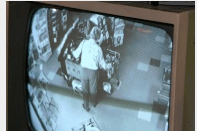 Preventing or taking measures to prevent a crime is much easier for a company than dealing with the results and the cost associated with dealing with it. Preventing shoplifting deals with a lot of situations that are unique to a particular store or situation, and the measures to dealing with them is different every time. If you are dealing with shoplifting or employee theft, follow the links below for more information about this topic and some measures you can take to prevent theft in your store.
Preventing or taking measures to prevent a crime is much easier for a company than dealing with the results and the cost associated with dealing with it. Preventing shoplifting deals with a lot of situations that are unique to a particular store or situation, and the measures to dealing with them is different every time. If you are dealing with shoplifting or employee theft, follow the links below for more information about this topic and some measures you can take to prevent theft in your store.
Shoplifting arrests at Eagan Outlet Mall raise question of bias
A majority of those cited or charged with shoplifting at Eagan’s new outlet mall have been people of color.
As soon as developers broke ground at the Twin Cities Premium Outlets in Eagan, police began preparing for an uptick in traffic and activity in the area.
Nearly 85 percent of those arrested or cited in connection with shoplifting calls at Eagan’s new outlet mall were people of color, according to a Star Tribune analysis of nearly 1,000 calls to police in the first eight months the center was open.
The percentage of blacks and other minorities arrested or charged with shoplifting offenses at Eagan’s Twin Cities Premium Outlet was higher than at nearby Burnsville Center, in all of Minneapolis or at a similar outlet mall in Albertville.
6 Low-Tech Ways to Reduce Shoplifting
It’s our instinct to turn to technology first when solving a problem. However, when it comes to preventing theft in your store, low-tech solutions can also be very effective. Using low-cost and free solutions can sometimes even require less employee training and troubleshooting than some high-tech tools.
Here are 6 low-tech ways to prevent theft in your store:
1. Put out the welcome mat. Shoplifters want to be anonymous and make as little contact with store employees as possible. One of the most effective ways to deter shoplifters is to greet every customer that walks into the store. “Don’t just shout “Good morning” over your shoulder, but make eye contact and greet the customer like you are happy to see them,” says Chris McGoey, security expert and founder ofCrime Doctor, a security firm. “Not only is it good customer service, a simple greeting can make potential shoplifters change their mind about stealing from your store because they know you can identify them.”
ANDERSON, SC – The City of Anderson Police Department offers the following shoplifting prevention tips. Shoplifting can cost your business thousands of dollars each year. Shoplifters may be any age, sex, economic, or ethnic background. There is no “typical” shoplifter. Often they work in pairs or groups to divert the clerk’s attention while they steal. Certain times of the day when employees are apt to be less alert are critical: Store opening and closing, during the lunch hour, dinner, or shift changes. Shoplifters learn to take advantage of crowded stores during peak hours.Effective prevention begins with an aware and alert staff.
Protective Measures
• Make the shoplifters feel watched. Elevate the cashier’s platform. Install mirrors that enable cashiers and sales people to see over and around displays. Install one-way glass in offices to enable employees to see into the store without being seen from the floor. Install video surveillance cameras.
• Post signs warning against shoplifting. Emphasize that you will prosecute. The best way to discourage shoplifters and keep your business from being tagged as an easy mark is to take a get- tough attitude and prosecute on the first offense.






